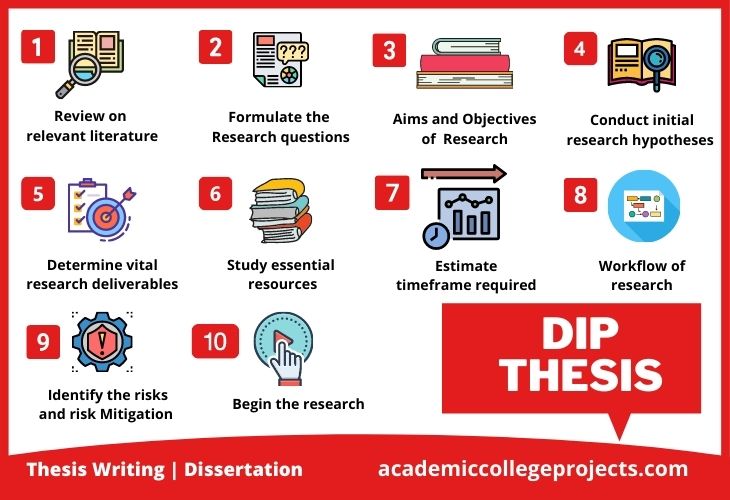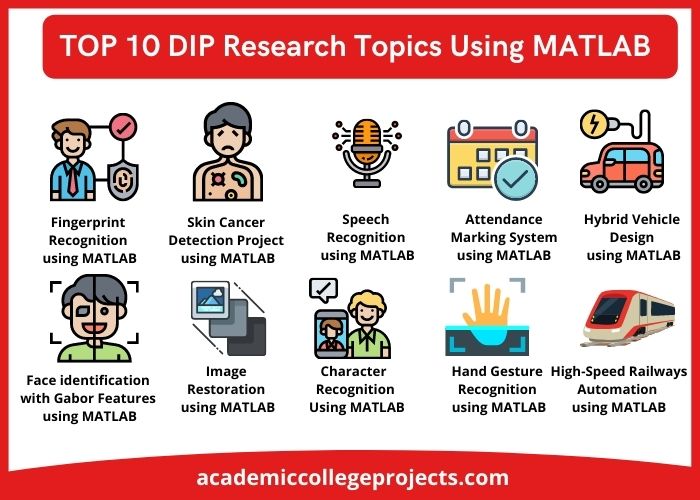Need some inspiration for your DIP Thesis research work? Learn more about digital image processing, its operations, recent interesting topics and steps involved in crafting best DIP thesis. Digital image processing is a method that is subjected to manipulate the raw image for bringing out the hidden information in the image through several classes: image analysis, compression, enhancement, restoration, and analysis. Most probably, the image enhancement process is performed by the heuristic algorithms. As a result, it extracts the essential data in the image by eliminating the unwanted information for detailed human viewer interpretation.
Next, we can see some notable steps that we should follow before the practical implementation of the research work for the DIP thesis research work.
Steps Involved in Crafting Novel DIP Thesis
These ideas help you to reach the research destination without any hurdles or complications.
- Step 1 – Review on relevant literature and understand the underlying principles
- Step 2 – Recognize and characterize the unknowns and formulate the research questions
- Step 3 – Define the aims and objectives of the research
- Step 4 – Conduct the initial research hypotheses and testing
- Step 5 – Determine the vital research deliverables
- Step 6 – Find and study the essential resources
- Step 7 – Plan and Estimate the timeframe required for research
- Step 8 – Develop the Workflow of research
- Step 9 – Identify the risks and risk Mitigation solutions for research
- Step 10 – Begin the research
What is the role of image restoration?
Similarly, the image restoration methods are intended to deal with damaged/corrupted images to determine the amount of image degradation through the mathematical or statistical description. Then, based on the degradation value, it takes effective measures to recover the original image.
Further, the image analysis approaches enable the image to be processed for better image perception and feature extraction. For instance, we can use edge extraction, image segmentation, motion, and texture analysis. To the exact point, the key characteristic of images is the large context information of the image needed for improved image representation. Next, we can see the general operations involved in the image processing projects.
This article is about the important information for about latest research topics for best DIP Thesis!!!
Image Processing Life Cycle
- Image Acquisition – Collect the images from the sensor/camera and transform them into digital format
- Color Space Conversion – Process the colored images and their spaces to increase the accuracy
- Noise Reduction – Removal of noise or unwanted portion from an image
- Contrast Enhancement – Enhance the low range dynamics and features of the image
- Image Resampling – Transform the image into another geometrical form
- Image Sharpening and Smoothing – Enhance the edges and reduce the image perturbation
- Image Enhancement and Restoration – Improve the quality and inception of the image
- Image Registration and Compression – Form the coordinates system of various images and reduce the image redundancy/storage
- Image Projection Calculation and Region Extraction – Analyze the different viewpoints and Extract specific portions by boundary
Most importantly, the above-specified methods are very significant to tackle the existing research issues. For instance: In the case of processing of satellite images, it supports various sensors such as Hyperspectral, Multispectral, Radar Interferometric, Radar Polarimetric, Radar LIDAR, and Radar LADAR.
Besides, it will cause issues in applying inappropriate optimization techniques. Some most common issues found in Image Processing to build your research DIP Thesis are given as follows,
What are the problems in Image Processing?
- Inappropriate Images / Content Recognition
- Scarcity in Training Data
- Complication in Analyzing Image Texture (for Image Segmentation)
The majority of complicated issues are highly possible in the integration of image processing with interconnected multi-disciplines. For instance, we can image processing with healthcare, computer vision, mobile computing, the automobile industry, etc. For more clarity, we have given some collaborated areas in the followings,
- 3D Dense Point Cloud Generation
- Vision: Stereo Pair Matching
- Generation of 3D Depth Map
- Object Tracking in Motion
- Image Stereo Rectification
Recent Research Topics for DIP Thesis
- COVID-19 Imaging and Analyzing
- Digitalized Document Processing and Analysis
- Geophysics Imaging and Processing
- Multi-resolution Image Processing and Filtering
- Image Sensing, Registration, Modeling, and Formation
- Improved Computational Imaging
- DL based Video and Image Quality Model Assessment
- Collaborative Image Coding, Compression, and Transmission
- Multiple View Video Processing for 3D-Stereoscopic Model
- Limited Multi-Labels Classification using Learning Techniques
- Image / Object Identification and Retrieval
- Hyperspectral (HS) and Multi-/spectral (MS) Color Imaging
- Biological and Biomedical Image Analytics for Public Health
- 3D Image Rendering, Synthesis, and Visual Perception
- Emerging Technologies in Image Processing Applications
- Image Texture Analysis, Classification, and Representation
- Efficient Image Enhancement and Restoration
- Information Fusion and Registration for 3D Motion Estimation
- Security, Digital Forensics and Biometrics
Nowadays, many of the DIP models incorporate any of the above concepts. Moreover, in android based mobile devices, DIP unifies many hi-tech technologies on mobile apps for human requirements. For the most part, it provides a modern way to build advanced projects with maximum efficiency.
DIP Operations
- Spatial Operation
- Spatial Median Filtering
- Smoothing Noisy Data
- Zoom-in and Zoom-out
- High / Low Pass Filtering
- Pseudo-Coloring
- False-Color Composite (FCC)
- Transform Operation
- Unsharp Masking
- Linear and Square Root
- Generalized / Wavelet Wiener Filtering
- Semantically Adversarial Learnable Filter
- Morphological Transformation
- Homomorphic Discrete Fourier Transformation (DFT)
- Point Operation
- Histogram Equalization
- Linear Contrast Stretching
- Slicing / Sliding Window
- Decorrelation and CLAHE Sketch
- Noise Clipping and Thresholding
Performance Metrics in DIP
- Signal To Reconstruction Error Ratio (SRE) – Calculate the error with respect to the signal power. And, it is suited to make errors comparable among images of brightness variation.
- Feature Similarity Indexing Method (FSIM) – Compare the original image with a restored image to find the feature and structural relationships. By the by, it depends on the gradient magnitude and phase congruency. Also, it has values between 00 – 11, where 11 means perfect feature similarity.
- Root Mean Square Error (RMSE) – Assess the quantity of variation per pixel that occurred at the time of processing. Also, it has only positive values, whereas 00 values represent the identical video or image.
- Universal Image Quality Index (UIQ) – It is modeled by the combined factors of below image distortion to improve quality,
- Luminance distortion
- Contrast distortion
- Loss of correlation
- Structural Similar Index Measure (SSIM) – Measure the amount of image quality degradation at the time of processing. For instance: data loss in compression or transmission. By the by, it figures out the visible perceptual/structural variance among two identical images. So, it is easy to identify the image that is supposed to do add-on processing.
- Spectral Angle Mapper (SAM) – Physically-based spectral classification determines the spectral similarity between the two spectra. For that, it computes the angle of spectra as vectors with equal dimensionality to the quantity of bands.
- Information Theoretic-Based Statistic Similarity Measure (ISSM) – With the static data, it includes the information theory. Ultimately, this theory helps to determine the correlation between the image intensity.
How to Write DIP Thesis Research Paper?
In general, a DIP thesis can be written in two formats: one is a typical “classic format,” and the other is “manuscript format.” The conventional thesis is made up of a basic introduction, literature survey, detailed methodologies explanations, discussion of experimental results, and conclusion. The manuscript Dip thesis relies on the main chapters. For the most part, in selecting the digital image processing thesis topics, one should be more careful on their research design.
Research Design Lifecycle
- Selection of interested Research Topic
- Refine the handpicked broad research topic into narrow
- Operationalizing the variables for qualitative and quantitative study
- Collect the required data or datasets from different sources
- Apply the proposed methodologies and analyze the obtained results
- Discuss the result for better interpretation
- Summarize the findings in the conclusion
For your information, here we are going to share some popular well-appreciated researches. And they are Convolution Neural Networks (CNN), Viola-Jones Face Detection, Object Detection by Deformable Part Based Models, Pedestrian / Human Detection based on HOG features, and many more. Further, we have listed few latest developments in digital image processing that sure to receive appreciation from top experts.
Some Current Trends in Image Processing are
- Enhancement of Deep Image In painting
- Automated 3 Dimensional Object Segmentation
- Real-time Object Tracking, Identification and Classification
- Advance Text Information Recognition and Extraction
- Information Hiding using Steganography Techniques on Digital Image
For more interesting research-oriented information on digital image processing, just contact our resource team. We are always ready to give our best guidance for DIP Thesis research work through both online and offline support during our business times.



